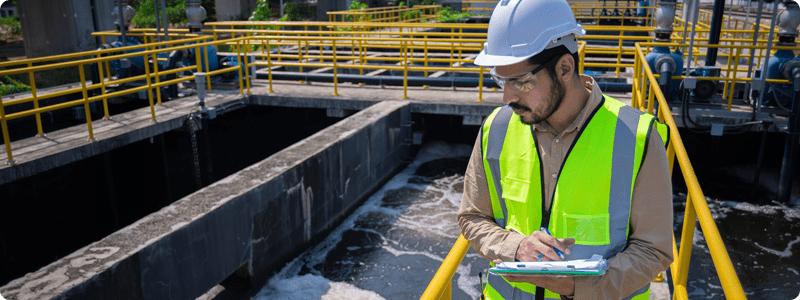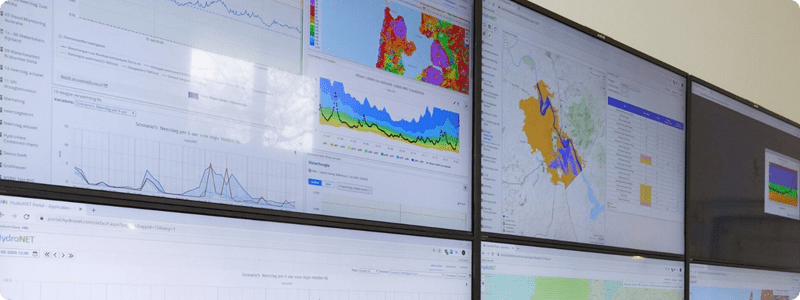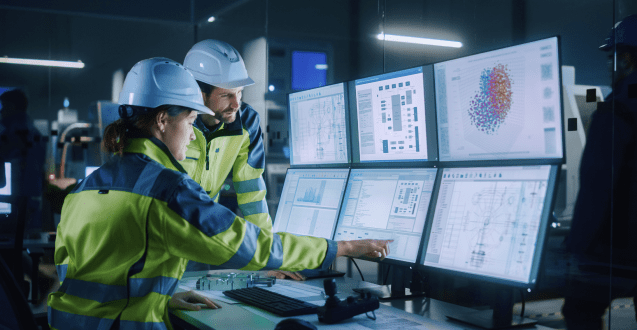Does Artificial Intelligence (AI) really have a role to play in securing safe, reliable, sustainable drinking water? The International Monetary Fund’s study on AI and the future of work found that almost 40 percent of global employment is exposed to AI, emphasizing how AI has permeated the workplace globally. Even before the rapid rise of AI in the workplace, recent research found about 60 percent of job functions today did not exist in 1940.

In our series, AI for Water, we’ll discuss critical questions, such as: Is it ethical for AI to replace people in the water workforce? For those currently applying AI, we discuss its goal and purpose and how success is defined. For those not yet benefiting from AI, we discuss why they are not and what is prioritized over the benefits of applying it now.
-
READ MORE
The risk with AI is that it has the potential to act as a rocket without fins, powerful but directionless. As a technology applicable to both a data science beginner and an advanced practitioner, our purpose is to help give AI its fins and make sure you’re able to make the most out of the tool to help inform when best to use AI, improve your operations, and gain efficiency.
I believe AI will influence the water sector significantly more than any technology we might have seen in recent history. It is an essential ingredient in any future innovation recipe. Similar to asking if your phone has Bluetooth connectivity or if your power drill is cordless, practitioners will begin with “How does your innovation use AI?”
The challenge is this: AI is not as simple as replacing a communication wire with a signal or a power cable with a rechargeable battery. It has wider implications and ethical issues.
So, what is AI in the context of water?
AI is the ability of machines to sense, reason, engage, and learn in a manner that seems intelligent. It can process large datasets quickly and accurately, identify patterns and make predictions, work continuously without fatigue, and generate highly personalized outputs. Unlike humans, in its current form, AI cannot display emotion, make decisions based on ethics, develop common sense, or think creatively. For those reasons, AI can augment but not replace human intelligence, creating an opportunity for collective intelligence, which uses the best of both.
Autodesk's Design and Make report found that generative AI is still an emerging technology that was little talked about by everyday people just two years ago, but most people across industries appear to be more than ready to take advantage of its promised productivity gains. According to the report, a whopping 56% of Autodesk customers say they are already approaching or have already achieved their goal of incorporating AI into their companies.
We’re at a critical turning point, and the next five years offer many benefits to early AI adopters in the water sector. Now that we know what AI can and cannot do, we can strategically apply AI in the water sector to identify pain points and create solutions that solve the problem in an efficient, data-driven manner that we couldn’t previously.
Global trends driving the need for AI in the water sector
The water sector faces multifaceted challenges shaped by global trends, including urbanization, an inconsistent regulatory landscape, climate change, water accessibility, and the pressing issue of a workforce shortage.
-
1. Urbanization
The United Nations estimates that today, more than half of the global population lives in urban areas, up from around one-third in 1950 and projected to increase to around two-thirds in 2050. Increased urbanization globally is exerting pressure on water supply and infrastructure. As populations grow, there is an increased need for proper sanitation services and clean water. AI has emerged as a critical tool for optimizing water management systems in densely populated areas. It offers operators the ability to monitor water quality in real time, predict demand fluctuations, and allocate resources adequately to meet the demands of urban populations.
-
2. Water resilience
There’s an urgent need for the water sector to improve its resilience to address issues of equity and accessibility, which have been exacerbated and, in some cases, caused by climate change. By leveraging AI, water management systems can optimize distribution networks to mitigate scarcity by identifying and addressing leakages and inefficiencies. Additionally, AI can facilitate equitable access to water resources by providing data-driven insights into consumption patterns, enabling fair allocation strategies that prioritize vulnerable communities and promote social equity in water distribution.
-
3. Workforce shortage
The EPA estimates one-third of the drinking and wastewater workforce in the U.S. is set to retire in the coming decade, and the industry has been struggling to attract talent. In a sector that has been slow to enter its digital era, losing the valuable knowledge of a workforce that has acted as the sector’s engine is cause for concern. By integrating AI and upskilling the workforce, the sector can improve its operational efficiency while also attracting and retaining top talent. In fact, Autodesk's Design and Make report found that employees are attracted to organizations that give them the tools to be productive and successful in their jobs, with 71% of respondents saying digital maturity helps attract talent.
-
4. Regulatory requirements
The regulatory landscape of the water sector can be described as new, complex, and evolving. The EU Artificial Intelligence Act is the first comprehensive regulation of AI by a major regulator anywhere, and it was just passed in March of 2024. In contrast, to date, water legislation in the U.S. has been divided between the federal government and the states, with the White House issuing guidance in March 2024 requiring federal agencies to designate chief AI officers within 60 days. The divided framework has created a patchwork of legislation that differs across the country. These regulations set requirements around the use of AI in the water sector, such as increased reporting; however, they also set out standards on how AI can be used to improve water quality and access. Even though regulation has been slow to evolve, the water sector should expect that regulation requiring the use of AI is inevitable.
What are the building blocks when it comes to AI and water management?
AI certainly isn’t the answer to all the challenges the water sector faces, but it has the ability, when paired with human intelligence, to tackle many of the sector’s most pressing problems. As we progress through the stages of AI adoption and water operators, managers, and stewards weigh the decision to implement AI, it’s imperative that we continue to consider the following:

Data privacy and ethics
AI facilitates efficiency and precision in water management, but it also necessitates conversations related to cybersecurity and ethics. Excluding technology, such as AI, isn’t an option, but as we collect data and digitize processes, they increasingly become a target of cyber-attacks. Taking meaningful action to prevent and detect harm is essential when considering implementing AI. Similarly, the ethical use of data is contingent upon proper data management. Striking a balance between leveraging AI for innovation and upholding data privacy requires transparent policies and frameworks that govern data sharing, storage, and utilization. Only through responsible stewardship of data can the water sector harness the full potential of technology while preserving individual privacy rights and ethical standards.

Commitment and investment
Implementing AI in the water sector requires significant investment from the government, utilities, and the public. Historically, the water sector has been trapped in an underinvestment cycle, leading to poor infrastructure and service, a reduced willingness to pay, and ultimately, less funding for investment, particularly in emerging markets. One of the benefits of AI is that it can reduce operating expenses, but it requires challenging a workforce that is accustomed to manual data management and analysis, investing in skills development to manage AI, and of course, the resources to implement AI and get it going. While the upfront investment in AI can seem extensive, there is value and benefit for those who take the leap in the form of lower operational costs, increased operational sustainability, higher retention and employee happiness, and improved operational efficiency.

Horizon planning
AI can deliver insights that will allow utilities to assess the progress they’ve made in the past five years, acknowledge the status of where they are today, and plan for five years into the future. For early adopters, there is a significant advantage to beginning their digital journey, as they strategically implement technology in a way that creates value, centered on improving operational efficiency and data reporting.

Capacity and capability
The U.S. Bureau of Labor Statistics (BLS) has reported that employment of water and wastewater treatment plants and system operators is projected to decline by 6% from 2022 to 2032, a trend that is not exclusive to the U.S. but is experienced globally. As a result, the water sector is at risk of losing a significant amount of its knowledge base as its workforce ages, and the sector is slow to see its workforce capacity expand. AI can bridge the capacity gap by managing labor-intensive data and providing real-time data trends. AI also offers the opportunity to revolutionize the workforce by prompting managers and operators to upskill their technology skills.

Connected and reliable data
Implementing AI-driven systems for real-time monitoring, optimization and management requires reliable data, which is where the partnership between human intelligence and AI is extremely important, as AI is only as valuable as the information it’s given. Creating parameters around data collection and Distributed Network Protocols allows utilities to capture and timecode the data so operators can adopt a system-wide approach to assessing a water/wastewater plant.
Notably, AI can also drive information into the consumer's hands to better help communities understand the value of water and improve water stewardship.
Staying ahead: Monitoring market shifts in the water sector

We are working in the age of a data explosion with less and less institutional knowledge available on demand to handle the unexpected. The proper tool in the age of data is AI. However, it does not solve every problem or provide the perfect solution. A battery-powered drill might be an exceptional advancement over a corded drill when you need to repair a leaking water pipe; however, it isn’t entirely useful if the tool you need is a hammer. Similarly, there is only so much brute force that can be applied to process a data tsunami in a static spreadsheet before you break the spreadsheet or drill. In this case, the most logical tool is AI, which has the power to efficiently process big data to get the answers you need.
Today’s phrase to delay obtaining the benefit of a new technology is “pilot study.” However, we’re challenging the water sector to think beyond the initial roadblocks that inevitably occur when adopting new technology and consider the long-term progress that is almost certainly guaranteed by adopting AI. Why? You might ask. In short, to enable a highly efficient team, improve employee safety, make a wider and lasting community impact, and positively impact communities who rely on safe water and sanitation services.
In the era of intelligent technologies, the fusion of AI and water management not only promises to mitigate water-related crises but also fosters a paradigm shift towards more resilient and resource-efficient societies.
We’re going to dive deeper into the challenges and benefits of implementing AI in the water sector. In our next article, we will explore the business case for AI.
For MIT Technology Review click here.

Can AI make waves in water utilities?
By 2030, the water industry will experience rapid growth in AI adoption. Compliance deadlines and cost efficiencies highlight the inevitability of it. Understand the barriers and solutions on how and when to implement AI.






